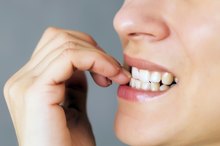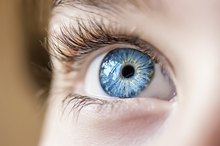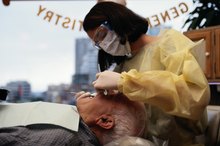What does fact checked mean?
At Healthfully, we strive to deliver objective content that is accurate and up-to-date. Our team periodically reviews articles in order to ensure content quality. The sources cited below consist of evidence from peer-reviewed journals, prominent medical organizations, academic associations, and government data.
The information contained on this site is for informational purposes only, and should not be used as a substitute for the advice of a professional health care provider. Please check with the appropriate physician regarding health questions and concerns. Although we strive to deliver accurate and up-to-date information, no guarantee to that effect is made.
Genetic diseases are caused by gene mutations that are inherited from one or both parents. Certain genetic diseases can cause abnormalities in the teeth, affecting the rate of development of primary (baby) and secondary (adult) teeth or their physical characteristics. Often, these genetic diseases affect the normal growth and health of other parts of the body, as well.
Amelogenesis Imperfecta
Amelogenesis imperfecta is a genetic condition that causes teeth to be abnormally small or discolored. Teeth are also likely to be pitted or grooved and more susceptible to being worn down and breaking. There are at least 14 forms of the condition, each with its own characteristic display of tooth abnormalities and form of genetic inheritance, according to the National Institutes of Health (NIH). Amelogenesis imperfecta is caused by mutations to the AMELX, ENAM and MMP20 genes and affects an estimated one in 14,000 people in the United States.
- Amelogenesis imperfecta is a genetic condition that causes teeth to be abnormally small or discolored.
- There are at least 14 forms of the condition, each with its own characteristic display of tooth abnormalities and form of genetic inheritance, according to the National Institutes of Health (NIH).
Dentinogenesis Imperfecta
Causes of Facial Asymmetry
Learn More
Dentinogenesis imperfecta is a genetic disorder that interferes with normal tooth development. It affects approximately one in 6,000 to 8,000 people, according to the National Institute of Health. There are three types of dentinogenesis imperfecta. Type I occurs in individuals who have another inherited disorder called osteogenesis imperfect (causes brittle bones), whereas type II and type III occur in those without other genetic disorders. Some researchers believe types II and III are part of a single disorder along with another condition called dentin dysplasia type II, which primarily affects baby teeth more than adult teeth. General symptoms of dentinogenesis imperfecta include tooth discoloration (blue-gray or yellowish-brown), tooth translucency and weaker than normal teeth which make them prone to erosion, breakage and loss.
- Dentinogenesis imperfecta is a genetic disorder that interferes with normal tooth development.
- Some researchers believe types II and III are part of a single disorder along with another condition called dentin dysplasia type II, which primarily affects baby teeth more than adult teeth.
48,XXYY Syndrome
Dental problems are also common. According to the NIH, the delayed appearance of primary and secondary teeth, crowded and/or misaligned teeth, numerous cavities and thin tooth enamel often accompany the disorder.
Hypohidrotic Ectodermal Dysplasia
Top Bone Diseases
Learn More
Those with the condition usually have absent teeth (hypodontia) or malformed teeth. It is common for malformed teeth to appear small and pointed.
Oculodentodigital Dysplasia
Oculodentodigital dysplasia is an extremely rare genetic disease (with fewer than 1,000 people diagnosed worldwide) that affects the eyes, fingers and teeth. Common tooth abnormalities include small or missing teeth, numerous cavities, weak enamel and early tooth loss, according to the NIH. The condition can also lead to small eyes, vision loss, webbed skin and neurological problems. An autosomal dominant disorder, it develops when only one mutated gene is inherited from a parent.
- Oculodentodigital dysplasia is an extremely rare genetic disease (with fewer than 1,000 people diagnosed worldwide) that affects the eyes, fingers and teeth.
Recombinant 8 Syndrome
Recombinant 8 syndrome is a rare disease of unknown incidence primarily affecting an Hispanic population descending from the San Luis Valley of Colorado and Northern New Mexico. Inherited in an autosomal dominant pattern, recombinant 8 syndrome causes distinctive facial abnormalities, moderate to severe intellectual disability and heart and urinary tract problems.
Related Articles
References
- National Organization for Rare Diseases. Amelogenesis imperfecta. Updated 2018
- Chan HC, Estrella NM, Milkovich RN, Kim JW, Simmer JP, Hu JC. Target gene analyses of 39 amelogenesis imperfecta kindreds. Eur J Oral Sci. 2011;119 Suppl 1(Suppl 1):311–323. doi:10.1111/j.1600-0722.2011.00857.x
- Centers for Disease Control and Prevention. Fluorosis. Updated March 8, 2019.
- Jain P, Kaul R, Saha S, Sarkar S. Tricho-dento-osseous syndrome and precocious eruption. J Clin Exp Dent. 2017;9(3):e494–e497. doi:10.4317/jced.53348
- Reddy P, Aravelli S, Goud S, Malathi L. Amelogenesis Imperfecta with Nephrocalcinosis: A rare association in siblings. Cureus. 2019;11(7):e5060. Published 2019 Jul 1. doi:10.7759/cureus.5060
- University of North Carolina Adams School of Dentistry. Amelogenesis imperfecta.
- Crawford PJ, Aldred M, Bloch-Zupan A. Amelogenesis imperfecta. Orphanet J Rare Dis. 2007;2:17. doi:10.1186/1750-1172-2-17
- National Institutes of Health Genetic and Rare Disease Information Center. Amelogenesis Imperfecta.
Writer Bio
Based in New York City, Tricia Mangan began her writing career in 2001. She has co-authored a National Cancer Institute report and a number of research articles that have appeared in medical journals. Tricia holds a Master of Arts in clinical psychology from Stony Brook University and boasts diverse clinical, research and teaching experience.








